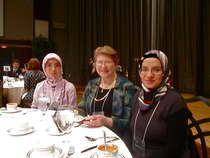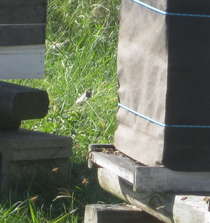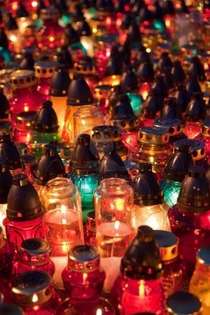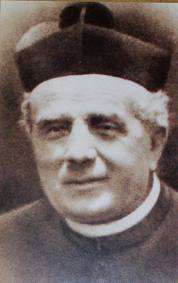 CONSTELLATION ORION Four saints are mentioned for remembrance today on Universalis The first, St. Elizabeth of Hungary was daughter of a king and became the loving wife of Ludwig, a count, and mother of three which is cause for sainthood itself. Ludwig supported what some considered her extravagant generosity to the poor and the sick. After her husband’s death, Elizabeth continued her life of service.
CONSTELLATION ORION Four saints are mentioned for remembrance today on Universalis The first, St. Elizabeth of Hungary was daughter of a king and became the loving wife of Ludwig, a count, and mother of three which is cause for sainthood itself. Ludwig supported what some considered her extravagant generosity to the poor and the sick. After her husband’s death, Elizabeth continued her life of service.
St. HIlda, also mentioned today, shared Elizabeth’s eagerness to reach out to all regardless of status. She is known as a woman of great learning and wisdom who was the founding abbess of the famous monastery of Whitby, a double monastery that had both women and men as members. They lived together in small houses of two or three people, and the men and women came together to worship. All types of people sought her out for guidance, including royalty. She gave freely of her gifts to all, and I imagine, teaching women to read and study Scripture, as well as to pray with it, was not common in her time.
She encouraged the man who cared for the animals, Caedmon, in his poetry and song. He became a brother at Whitby and is the first English poet that we know by name.
St Hugh of Lincoln is another mentioned today. He was a Carthusian at the monastery of La Grande Chartreuse until, asked by King Henry II of England, he became prior of a Carthusian house in England. Later he was named bishop, a position he accepted only when directed to do so by the abbot of La Grande Chartreuse. He worked with his hands helping to extend the cathedral building, but is known primarily for his commitment to justice and service to the poor.
These three saints stood out to me as I read readings from Amos for the Hours today. Amos was prophet in the 700’s BCE, when both Israel and Judah knew times of great prosperity and excess. The rich lived lavishly at the expense of the poor, and Amos spoke out forcefully against that, reminding them of God’s vengeance against those who do not keep his commands
Amos refers to God not as Lord of the Jewish people only, but as God of the universe. Some of the most poetic lines come from these descriptions:
He it was who formed the mountains, created the wind, reveals his mind to man, makes both dawn and dark, and walks on the top of the heights of the world; the Lord, the God of Hosts, is his name.Amos 4:13
He made the Pleiades and Orion, who turns the dusk to dawn and day to darkest night. He summons the waters of the sea and pours them over the land. The Lord is his name.Amos 5:8)
He has built his high dwelling place in the heavens and supported his vault on the earth; he summons the waters of the sea and pours them over the land. The Lord is his name.Amos 9:6
Being a night sky watcher, I particularly love the verse that reminds us that God created the universe and names Orion among the great constellations. Orion has been my companion for years, no matter where I lived. I could walk outside at night, look at the sky, and see Orion watching over me. He was my guardian and comfort when I was lonely or distressed. One view of that cluster of stars reminded me of the Holy Mystery that set the universe in motion. And I felt a small part of a bigger plan.
Today, we would do well to remember God’s care for the poor and commandment to care for them. At a time when some members of our “Super Committee” cannot agree on raising taxes as part of a fix for the economy, but insist instead on protecting the richest among us, Orion and the stars of the heavens remind us of the injustice of such a stance.

 A friend invited me to attend the
A friend invited me to attend the  I encourage you to visit the websites of these two organizations. You may be surprised at the variety of opportunities these nonprofit groups offer to all: luncheons, lectures, interfaith dinners, morning conversations, community service. And the opportunity to develop friendships that span the globe, sharing what is most basic to all human beings: family, faith, community, and the common good. The way to peace is made with small steps. It is made through person to person interaction and service.
I encourage you to visit the websites of these two organizations. You may be surprised at the variety of opportunities these nonprofit groups offer to all: luncheons, lectures, interfaith dinners, morning conversations, community service. And the opportunity to develop friendships that span the globe, sharing what is most basic to all human beings: family, faith, community, and the common good. The way to peace is made with small steps. It is made through person to person interaction and service.  PHOTO: Mary van Balen PICASSO PLATE – GIFT FROM WOMAN ACTIVE IN THE FRENCH PEACE MOVEMENT The Scripture reading from Morning Prayer today (Proverbs 8. , 32-36) as well as the OT reading from Mass (Ws 7. 22b-8.1) speak of the importance of seeking Wisdom and Understanding: “Happy are those who keep my ways. Listen to instruction and grow wise…Happy the one who listens to me, attending daily at my gates, keeping watch at my doorstep.”
PHOTO: Mary van Balen PICASSO PLATE – GIFT FROM WOMAN ACTIVE IN THE FRENCH PEACE MOVEMENT The Scripture reading from Morning Prayer today (Proverbs 8. , 32-36) as well as the OT reading from Mass (Ws 7. 22b-8.1) speak of the importance of seeking Wisdom and Understanding: “Happy are those who keep my ways. Listen to instruction and grow wise…Happy the one who listens to me, attending daily at my gates, keeping watch at my doorstep.”
 PHOTO: Mary van Balen I took advantage of a day off to accomplish a number of things: doctor appointment, hair cut, and repotting plants. The day was too beautiful not to spend some of it outside and my hospitable friend, Melanie happily offered her time and her place. We have walked paths that wind across her property in every season. We have watched for comets and stars in dark hours of the morning. As I drove to her home, I felt my spirit become lighter anticipating a shared few hours.
PHOTO: Mary van Balen I took advantage of a day off to accomplish a number of things: doctor appointment, hair cut, and repotting plants. The day was too beautiful not to spend some of it outside and my hospitable friend, Melanie happily offered her time and her place. We have walked paths that wind across her property in every season. We have watched for comets and stars in dark hours of the morning. As I drove to her home, I felt my spirit become lighter anticipating a shared few hours. Melanie and I walked around the pond and circled by the bee hives. The man who cares for them had winterized them, but bees were busily flying in and out. In November. That seems late to me, but I am not a bee keeper. We watched for a while, and when after a simple lunch, when I left for my appointments, I stopped in the drive long enough to watch the bees again and take a few photos. Buzzing became louder, and when a bee landed on my hand, I decided the time had come to leave.
Melanie and I walked around the pond and circled by the bee hives. The man who cares for them had winterized them, but bees were busily flying in and out. In November. That seems late to me, but I am not a bee keeper. We watched for a while, and when after a simple lunch, when I left for my appointments, I stopped in the drive long enough to watch the bees again and take a few photos. Buzzing became louder, and when a bee landed on my hand, I decided the time had come to leave. From the Exultet:
From the Exultet: All Saints Day II by Kadinsky The short reading for today’s
All Saints Day II by Kadinsky The short reading for today’s  PHOTO: Mary van Balen The morning after Halloween, my mom’s large, silver mixing bowl filled with small candy bars sits on my table, tempting me. Why not have a bit of sweet to start the morning. I had feared this would happen. Being new to the neighborhood, I had no idea if trick or treaters would find their way to my door, so I prepared with a few bags of candy bars. When my neighbor appeared outside in the afternoon ready to take a walk, I asked her about Halloween “traffic.”
PHOTO: Mary van Balen The morning after Halloween, my mom’s large, silver mixing bowl filled with small candy bars sits on my table, tempting me. Why not have a bit of sweet to start the morning. I had feared this would happen. Being new to the neighborhood, I had no idea if trick or treaters would find their way to my door, so I prepared with a few bags of candy bars. When my neighbor appeared outside in the afternoon ready to take a walk, I asked her about Halloween “traffic.” 

 All Souls Day, a day of prayer for those who have died but are not yet purified of the result of their sins, is commemorated on Nov. 2 in the Roman Catholic church. Those still waiting to be in the presence of God, the “beatific vision,” are those in need of prayer. In some countries, people visit cemeteries and decorate them with flowers and candles on Nov. 1 and 2.
All Souls Day, a day of prayer for those who have died but are not yet purified of the result of their sins, is commemorated on Nov. 2 in the Roman Catholic church. Those still waiting to be in the presence of God, the “beatific vision,” are those in need of prayer. In some countries, people visit cemeteries and decorate them with flowers and candles on Nov. 1 and 2. 

 Sr. Bonifacia You shall not wrong or oppress a resident alien, for you were aliens in the land of Egypt. You shall not abuse any widow or orphan. If you do abuse them, when they cry out to me, I will surely heed their cry; my wrath will burn, and I will kill you with the sword, and your wives shall become widows and your children orphans. If you lend money to my people, to the poor among you, you shall not deal with them as a creditor; you shall not exact interest from them. If you take your neighbor’s cloak in pawn, you shall restore it before the sun goes down; for it may be your neighbor’s only clothing to use as cover; in what else shall that person sleep? And if your neighbor cries out to me, I will listen, for I am compassionate. Ex 22. 21-27
Sr. Bonifacia You shall not wrong or oppress a resident alien, for you were aliens in the land of Egypt. You shall not abuse any widow or orphan. If you do abuse them, when they cry out to me, I will surely heed their cry; my wrath will burn, and I will kill you with the sword, and your wives shall become widows and your children orphans. If you lend money to my people, to the poor among you, you shall not deal with them as a creditor; you shall not exact interest from them. If you take your neighbor’s cloak in pawn, you shall restore it before the sun goes down; for it may be your neighbor’s only clothing to use as cover; in what else shall that person sleep? And if your neighbor cries out to me, I will listen, for I am compassionate. Ex 22. 21-27 Both these holy people gave their lives in service to the most vulnerable of God’s people. They were open to receive God’s love and to be God’s hands and heart on earth. They were Compassion.
Both these holy people gave their lives in service to the most vulnerable of God’s people. They were open to receive God’s love and to be God’s hands and heart on earth. They were Compassion.